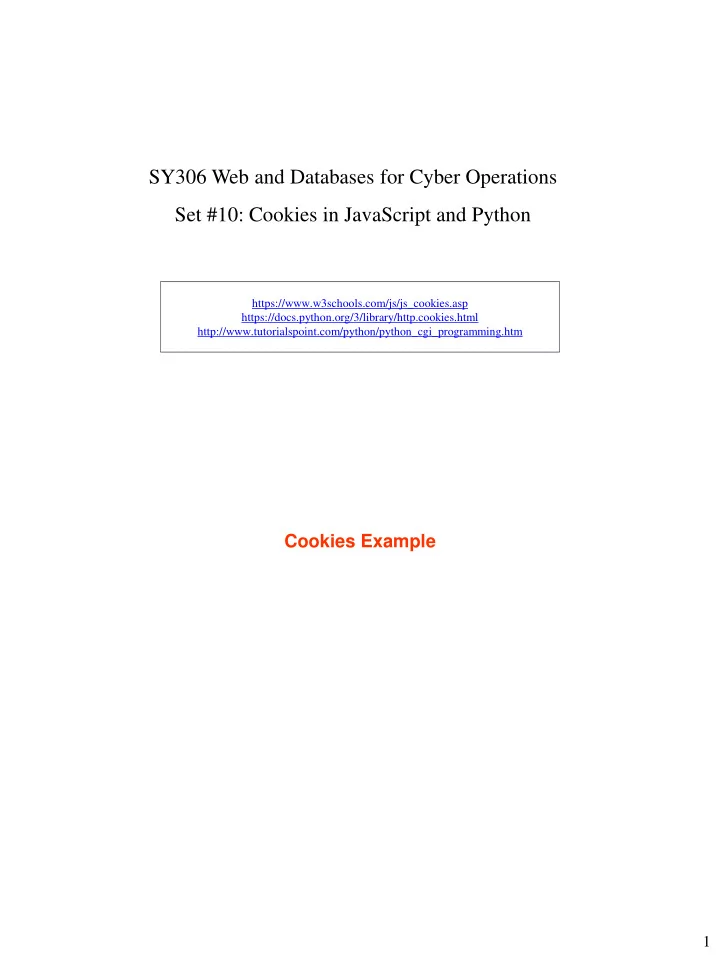

SY306 Web and Databases for Cyber Operations Set #10: Cookies in JavaScript and Python https://www.w3schools.com/js/js_cookies.asp https://docs.python.org/3/library/http.cookies.html http://www.tutorialspoint.com/python/python_cgi_programming.htm Cookies Example 1
JavaScript: Using Cookies • Cookie – Data stored on _____________ to maintain information about client during and between browser sessions – A string: identifier=value pairs separated by ; – Can be accessed through document.cookie property – Set expiration date using expires keyword – Use escape or encodeURI function to convert non- alphanumeric characters to hexadecimal escape sequences – unescape or decodeURI function converts hexadecimal escape sequences back to English characters Why Cookies 2
Cookie Attributes • Expires • Path • Domain • Secure • Http-only • Identifier (name) • Value JavaScript: Using cookies Accessing a cookie: var cookies = document.cookie .split (“;”); for( i = 0; i < cookies.length; i++ ) var cookie = cookies[i ].split(“=“); … Setting a cookie: document.cookie = "name=" + escape("J Smith"); document.cookie = "name=" + escape (“Bob K"); document.cookie = "rank=" + escape("Captain"); 3
Exercise #1: JS: Ask user for favorite quote using a window prompt. Save quote in a cookie identified by “favQuote”. Display quote on the page. Storing Cookies – More Realistic • By default, cookies expire when session ends • Set “expires” attribute to make it stick around longer function createCookie(identifier,value,days) { if (days) { var date = new Date(); date.setTime(date.getTime()+(days*24*60*60*1000)); var expires = "; expires="+date.toGMTString(); } else var expires = ""; document.cookie = identifier+"="+escape(value)+expires; } function eraseCookie(identifier) { createCookie(identifier,"",-1); } (modified from http://www.quirksmode.org/js/cookies.html) 4
Reading Cookies – More Realistic // Return the 'value' of the cookie with identifier 'desiredId' // returns null if no match found. function readCookie(desiredId) { // First split the pairs apart on '; ' var pairs = document.cookie.split("; "); // Now split each pair on '='. Check if have a match for (var i=0; i < pairs.length; i++) { var aPair = pairs[i]; // split into desired parts and check for match var cookieTokens = aPair.split("="); var id = cookieTokens[0]; var value = cookieTokens[1]; if (id == desiredId) { // found desired cookie -- return value return unescape(value); } } return null; // no match } Exercise #2: JS: Read the value of cookie identified by “favQuote” and display it in a pop -up msg if it exists, otherwise display “no quotes” 5
Cookies – Java Script and Python • Cookies with JavaScript – Create cookie ( document.cookie = “color=red”;) – Read cookie • Read and parse document.cookie • Use readCookie() function to help with this – Where are cookies stored?? • Cookies with Python – Ask browser to create cookie by printing “Set - cookie…” BEFORE printing “Content - type …” – Browser always sends appropriate cookies back to server with request – Read cookie • Access “HTTP_COOKIE” environment variable (from os import environ) • Use SimpleCookie class (from http import cookies) – Where are cookies stored?? • Cookies created with Python can be read via JavaScript and vice versa HTTP Protocol – HTTP Response HTTP/1.0 200 OK Set-Cookie : theme=light Set-Cookie : session=5gd7324dx; Expires=Wed, 11 Oct 2018 12:27:03 GMT Content-type : text/html <!DOCTYPE html> <html xmlns =“http://www.w3.org/1999/ xhtml ”> … 6
Create Cookies with Python (Assume this file invoked from a HTML form with fields name, and color) #!/usr/bin/env python3 set10_createCookies.py – part1 from http import cookies import urllib.parse, cgi, cgitb #get parameters params = cgi.FieldStorage() name = params.getvalue("name") height = params.getvalue("height") color = params.getvalue("color") #set cookies #set expiration time in 1 hour expires = 60*60; mycookie = cookies.SimpleCookie() mycookie["Name"] = name mycookie["Color"] = color mycookie["Color"]['expires']= expires print (mycookie) #BEFORE content-type line print( "Content-type:text/html\n"); print (""“ <!DOCTYPE html> <html> set10_createCookies.py – part2 <head> <meta charset = "utf- 8“> <title>Storing cookies</title> </head> <body> <h1>2 cookies were stored!</h1> ""“) print ("<h2>Name: "+ name + "<br /> Color: "+color + "</h2>"); print("</body></html>"); 7
Read Cookies With Python #!/usr/bin/env python3 from http import cookies import os set10_readCookies.py – part1 #read cookies name = "" color = "" if 'HTTP_COOKIE' in os.environ: cookie_string=os.environ.get('HTTP_COOKIE') mycookie=cookies.SimpleCookie() mycookie.load(cookie_string) try: name=mycookie['Name'].value color = mycookie['Color'].value except KeyError: name="" print ("Content-type: text/html\n") print ("""\ <!DOCTYPE html> <html> set10_readCookies.py – part2 <head> <meta charset = "utf-8"> <title>Reading cookies</title> </head> <body> """) if name or color: print ("<h1>Cookies found!</h1>"); print ("<h2>Name: "+name+"</h2>"); print ("<h2>Color: " + color +"</h2>"); else: print ("<h1>Could not find cookies for Name or Color</h1>") ; print("</body></html>"); 8
Exercise #4: Python: a) Create a cookie with identifier “ favQuote ” and content “DTT/FSA” b) change your program to store the quote provided by user (not hardcoded) through CGI – param name “quote” Remember • Relevant cookies always sent by browser to the server • Can create with JavaScript and read with Python • Or create with Python and read with JavaScript 9
Recommend
More recommend